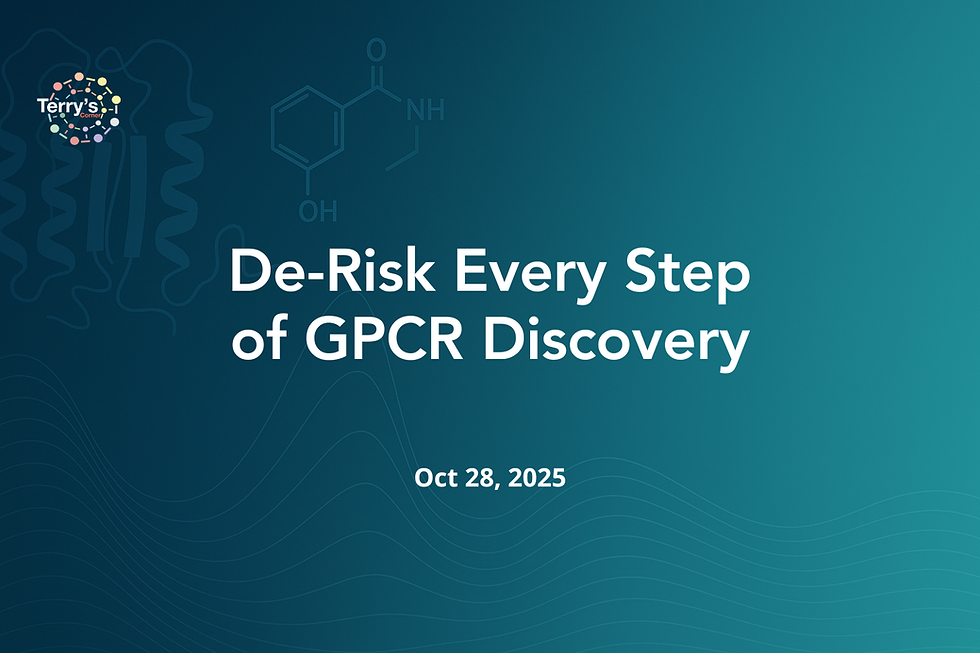Decoding Schild Analysis: The Pharmacologist’s Lens on Competitive Antagonism
- Terry's Desk

- 2 days ago
- 4 min read
Updated: 4 hours ago

Drug discovery often assumes receptor inhibition follows simple rules—agonist binds, antagonist blocks, and data fit neatly into predictable curves. Yet, any pharmacologist who’s pushed beyond textbook theory knows: biology rarely plays fair. Schild analysis remains one of the few conceptual anchors that can tell us when “simple” truly is simple—and when deeper receptor dynamics are at play.
In this session, you’ll gain:
A clear conceptual map of Schild analysis and its origins.
Insights into applying it to partial, inverse, and hemi-equilibrium systems.
Ways Schild plots reveal hidden complexities like allosterism and receptor heterogeneity.
The Legacy of Schild Analysis
Schild analysis was born from an elegantly simple equation published by Sir John Gaddum in 1937. That paper quantified how one drug could block another’s access to a receptor—a framework that Heinz Schild later formalized into the tool we use today.
At its heart, Schild analysis isn’t about math—it’s about validation. It asks whether the antagonism observed is truly competitive or if unseen factors distort the result.
It quantifies the degree of agonist blockade using dose ratios.
It infers the affinity (Kᵦ) of an antagonist by linking concentration shifts to receptor occupancy.
Its strength lies not in complexity, but in the rigor of its simplicity.
In the full lecture, Dr. Kenakin reveals how Schild’s equation became the first real “receptor test”—a filter that separates mechanistic truth from experimental illusion.
Simple Competitive Antagonism
A truly competitive antagonist obeys four essential rules—each serving as a gatekeeper to validity.
Criteria for genuine competition:
Parallel rightward shift of the agonist concentration–response curve.
No reduction in the maximal response (the receptor can still be fully activated).
Linearity of the Schild regression (log(DR–1) vs. antagonist concentration).
Slope ≈ 1, indicating equilibrium binding.
In practice, these criteria test the purity of interaction. Deviations—like reduced maximal responses or non-linear regressions—signal confounding kinetics, receptor mixing, or non-equilibrium conditions.
As Dr. Kenakin emphasizes, “Schild plots don’t just confirm competition—they expose when competition is an illusion.”
When Rules Bend: Non-Ideal Systems
Not every system plays by Schild’s rules. Some responses—especially in calcium assays or complex tissue systems—depress the maximum agonist effect. Others show subtle curvature or slope deviations.
Here, the Schild plot becomes a diagnostic tool rather than a checkbox test:
Slopes >1 often mean incomplete equilibration; lower antagonist concentrations haven’t had enough time to bind.
Slopes <1 may reveal allosteric modulation, where the antagonist binds at a secondary site.
Curvature can signify heterogeneous receptors or mixed response mechanisms.
These deviations aren’t failures—they’re clues. Schild analysis turns receptor pharmacology into detective work, spotlighting mechanistic fingerprints buried in dose–response data.
Extending Schild to Partial Agonists
Partial agonists complicate things—they activate receptors but less effectively than full agonists. When these same molecules act as antagonists, their curves shift not only in position but also in shape.
In the full lecture, you will learn how to extract affinity even in this dual-behavior scenario:
Focus on the parallel portions of the curves.
Derive dose ratios from those sections only.
Fit those points to the Schild equation for an accurate estimate of Kᵦ.
Partial agonists don’t break Schild analysis—they refine it. The model’s flexibility accommodates both agonism and antagonism as long as the analysis targets equilibrium regions.
Inverse Agonists and Hemi-Equilibria
In systems with constitutive receptor activity, inverse agonists reduce baseline signaling. Schild analysis still applies—if used carefully.
The depression of basal response is accounted for by focusing on curve segments where inhibition behaves competitively.
Even when maximal responses are altered, affinity constants remain extractable from correctly chosen data regions.
Calcium flux assays, though tricky, yield valid Schild plots when analysis excludes non-equilibrium maxima.
These adaptations underscore Schild’s resilience—it remains one of the few analytical frameworks flexible enough to handle inverse agonists, partial agonists, and non-ideal systems without collapsing conceptually.
The Quick Glance: pA₂ as Shortcut
Sometimes, discovery projects don’t have the luxury of full curve analyses. That’s where pA₂ values come in—a quick estimate of antagonist affinity from a single concentration.
Defined as the negative log of the antagonist concentration that causes a twofold agonist EC₅₀ shift.
Under ideal equilibrium, pA₂ ≈ pKᵦ.
Caveat: Without multiple concentrations, competitive nature remains an assumption.
pA₂ is an elegant glimpse—but not the whole picture. It’s a screening tool, not a substitute for rigorous Schild validation.
Schild as a Window into Mechanism
Beyond affinity estimation, Schild analysis acts as a window into receptor behavior. It can uncover what’s really happening inside a complex system.
Common revelations include:
Mixtures of receptor subtypes producing hybrid response patterns.
Allosteric vs. orthosteric inhibition, distinguishable by the plateauing of effect.
Incomplete equilibration, where kinetics distort linearity.
In practice, a deviation in slope or curvature isn’t noise—it’s the receptor speaking. Schild analysis translates that language. Each non-linearity is a coded message about the true mechanism.
Learn how to reframe Schild analysis not as a relic of linear regression, but as an early machine-learning algorithm in human form: trained to detect outliers that matter.
From Equilibrium to Exploration
Schild’s greatest value today isn’t computational—it’s conceptual. Modern pharmacology has powerful modeling software, yet Schild analysis remains the litmus test for mechanism.
Its purpose extends far beyond its 1930s origin:
It teaches equilibrium thinking—recognizing when binding truly stabilizes.
It sharpens interpretation—distinguishing real affinity from apparent effect.
It encourages skepticism—forcing researchers to prove competition before quantifying it.
In Kenakin's words, “Every slope, every curvature, every failure to fit—those are the whispers of the receptor.” Schild analysis remains the simplest, most revealing conversation we can have with biology.
Watch the course trailer 👇
Why Terry’s Corner
Weekly pharmacology lectures by Dr. Terry Kenakin, monthly AMAs, and a growing on-demand library help scientists sharpen fundamentals, challenge assumptions, and strengthen pipelines. Built for pharmacologists refining tools, discovery teams solving bottlenecks, and leaders seeking credible insight fast. GPCR innovation is accelerating—those who act now will define tomorrow’s breakthroughs.





Comments